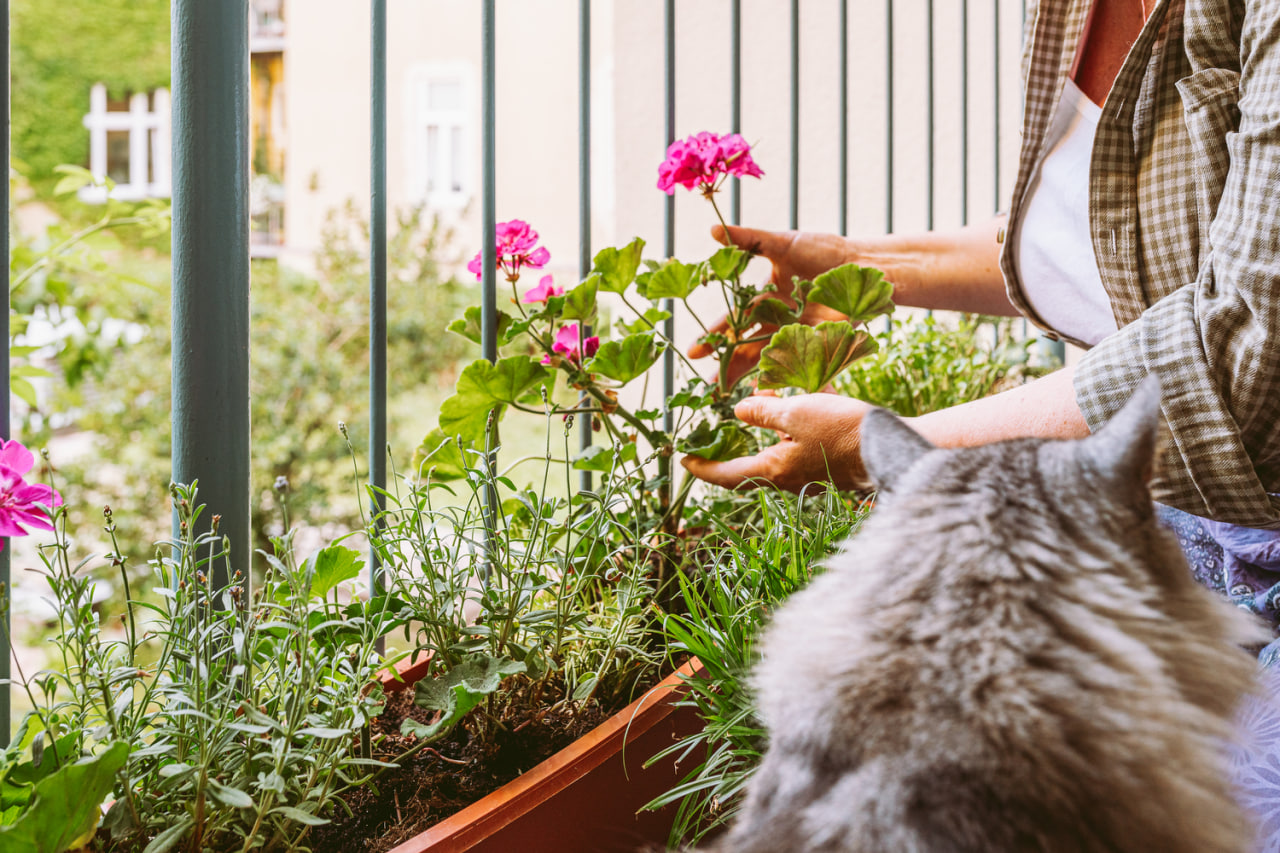Introduction:
A balcony herb garden is a fantastic way to bring fresh flavors and fragrances into your home, especially if you have limited outdoor space. Growing herbs on your balcony is not only easy, but it can also be incredibly rewarding. Whether you’re a culinary enthusiast looking to spice up your meals or someone who enjoys the beauty and scent of fresh greenery, a balcony herb garden can be your perfect solution. In this blog, we’ll guide you through the process of creating your own balcony herb garden, from selecting the best herbs to choosing the right containers and taking care of your plants.
1. Why Start an Herb Garden on Your Balcony?
Herbs are some of the easiest plants to grow, and they are especially well-suited for small spaces like balconies. Here’s why starting an herb garden on your balcony is a great idea:
- Convenience: Having fresh herbs at your fingertips makes cooking so much easier. Imagine stepping outside to snip some basil for your pasta or mint for a refreshing tea.
- Space Efficiency: Herbs are typically compact and thrive in containers, which means they don’t require much space. Even a small balcony can accommodate a variety of herbs.
- Health Benefits: Many herbs have medicinal properties, such as lavender for relaxation or rosemary for boosting memory. Growing them on your balcony allows you to enjoy these benefits right outside your door.
- Cost-Effective: Buying fresh herbs at the store can be expensive, and often you only need a small amount. By growing your own, you’ll save money and reduce food waste.
2. Choosing the Right Herbs for Your Balcony
The first step in creating a balcony herb garden is selecting the right herbs. Not all herbs are suited for container gardening, so it’s essential to choose varieties that will thrive in pots and small spaces.
Here are some popular herbs that are perfect for balcony gardens:
- Basil: Basil loves warm weather and plenty of sunlight. It’s ideal for sunny balconies and is perfect for adding to salads, pasta dishes, or making homemade pesto.
- Mint: Mint is hardy and grows well in partial shade, which makes it great for balconies that don’t receive full sun all day. However, mint can spread quickly, so it’s best to plant it in a container to prevent it from overtaking your garden.
- Thyme: Thyme is a low-maintenance herb that thrives in full sun. It’s perfect for small containers or hanging baskets and can be used in a variety of savory dishes.
- Rosemary: This herb prefers sunny spots and well-drained soil, making it perfect for a balcony that receives a lot of sunlight. Rosemary is great for roasting meats or adding flavor to potatoes.
- Parsley: Parsley can thrive in partial sun and is an excellent choice for shaded balconies. It’s a versatile herb used in soups, stews, salads, and garnishes.
- Oregano: Oregano thrives in full sun and well-drained soil, and it’s a great choice for growing in containers. It’s often used in Mediterranean dishes, especially in tomato-based sauces.
- Chives: Chives are a great herb for beginners. They thrive in full sun and are perfect for adding flavor to salads, baked potatoes, or scrambled eggs.
Tip: When selecting herbs, consider your balcony’s climate, the amount of sunlight it gets, and the space available. Most herbs require 4–6 hours of direct sunlight per day to grow well, but some, like mint and parsley, can tolerate partial shade.
3. Choosing the Right Containers for Your Herbs
Herbs grow well in containers, and choosing the right pot or planter is crucial to their success. Here are some container options to consider:
- Traditional Pots: Classic terracotta or ceramic pots are great for herbs like basil, thyme, and rosemary. These pots offer excellent drainage, which is crucial for preventing root rot. Choose pots with drainage holes at the bottom to allow excess water to escape.
- Hanging Baskets: Hanging baskets are a space-saving option that works well for herbs like mint, parsley, and oregano. They can be hung on balcony railings or hooks, allowing you to grow herbs without taking up floor space.
- Window Boxes: If you have a railing or ledge on your balcony, window boxes are an excellent choice for growing herbs. These containers provide a long, narrow planting space and are ideal for herbs that spread out, like oregano and thyme.
- Vertical Planters: If you’re really limited on space, consider using a vertical planter or a tower planter that allows you to grow multiple herbs in a single vertical structure. These planters are perfect for small balconies and can be placed against a wall or railing.
- Raised Bed Containers: Raised garden beds, which are slightly larger, can be a great option if you have more space on your balcony. They allow for easy access to the plants and can accommodate several different herbs at once.
Tip: Make sure your containers are deep enough to accommodate the roots of the herbs. Ideally, choose containers that are at least 8 inches deep for most herbs.
4. Planting and Caring for Your Balcony Herb Garden
Once you’ve selected your herbs and containers, it’s time to plant them! Here are some simple steps to follow to ensure your herbs thrive:
- Soil: Use a high-quality potting mix that drains well. Avoid garden soil, as it can be too heavy and may retain too much moisture. For herbs like rosemary and thyme, adding a bit of sand to the mix will improve drainage.
- Planting: Start by placing a layer of small stones or gravel at the bottom of the pot to ensure proper drainage. Then, fill the pot with your potting mix, leaving enough room for the herb roots. Gently place the herb in the pot, ensuring it is planted at the same depth as it was in its original container. Water lightly after planting to settle the soil.
- Watering: Herbs prefer to be watered when the top inch of soil feels dry. Be careful not to overwater, as herbs like rosemary and thyme are drought-tolerant and can suffer from root rot if the soil is too soggy. Make sure your containers have drainage holes to avoid waterlogging.
- Fertilizing: Herbs generally don’t need heavy feeding. You can feed them with a balanced liquid fertilizer every 4–6 weeks during the growing season, but be careful not to over-fertilize, as this can lead to excessive leaf growth at the expense of flavor.
- Pruning: Regular pruning will help your herbs grow more vigorously and keep them from becoming leggy. Pinch back the stems to encourage bushier growth, and remove any flowers that may appear (especially on basil) as they can reduce the flavor quality of the leaves.
- Harvesting: You can begin harvesting your herbs as soon as they’re large enough. For most herbs, it’s best to snip off the leaves from the top down, which encourages the plant to grow more. Avoid cutting too much at once to give the plant time to regrow.
Tip: Regularly trim your herbs to prevent them from becoming overgrown. Removing flower heads will also encourage more leaf production, which is what you want for culinary use.
5. Making the Most of Your Balcony Herb Garden
Your balcony herb garden can become a beautiful and functional space with just a little creativity. Here are some ideas to maximize the potential of your garden:
- Create an Herb Corner: Dedicate a small corner of your balcony to a little herb haven. Group plants together in pots and use trellises or plant supports to give your garden some vertical structure.
- Use Planters as Décor: Decorative planters and pots can be a lovely addition to your balcony décor. Choose colorful pots or use a mix of different container styles to add visual interest to your herb garden.
- Incorporate Other Plants: Herbs can be complemented by flowers like marigolds, petunias, or nasturtiums, which add color and can even help deter pests from your plants.
- Add Lighting: If you’re growing your herbs in the evenings, consider adding outdoor string lights or fairy lights to create a cozy atmosphere on your balcony.

